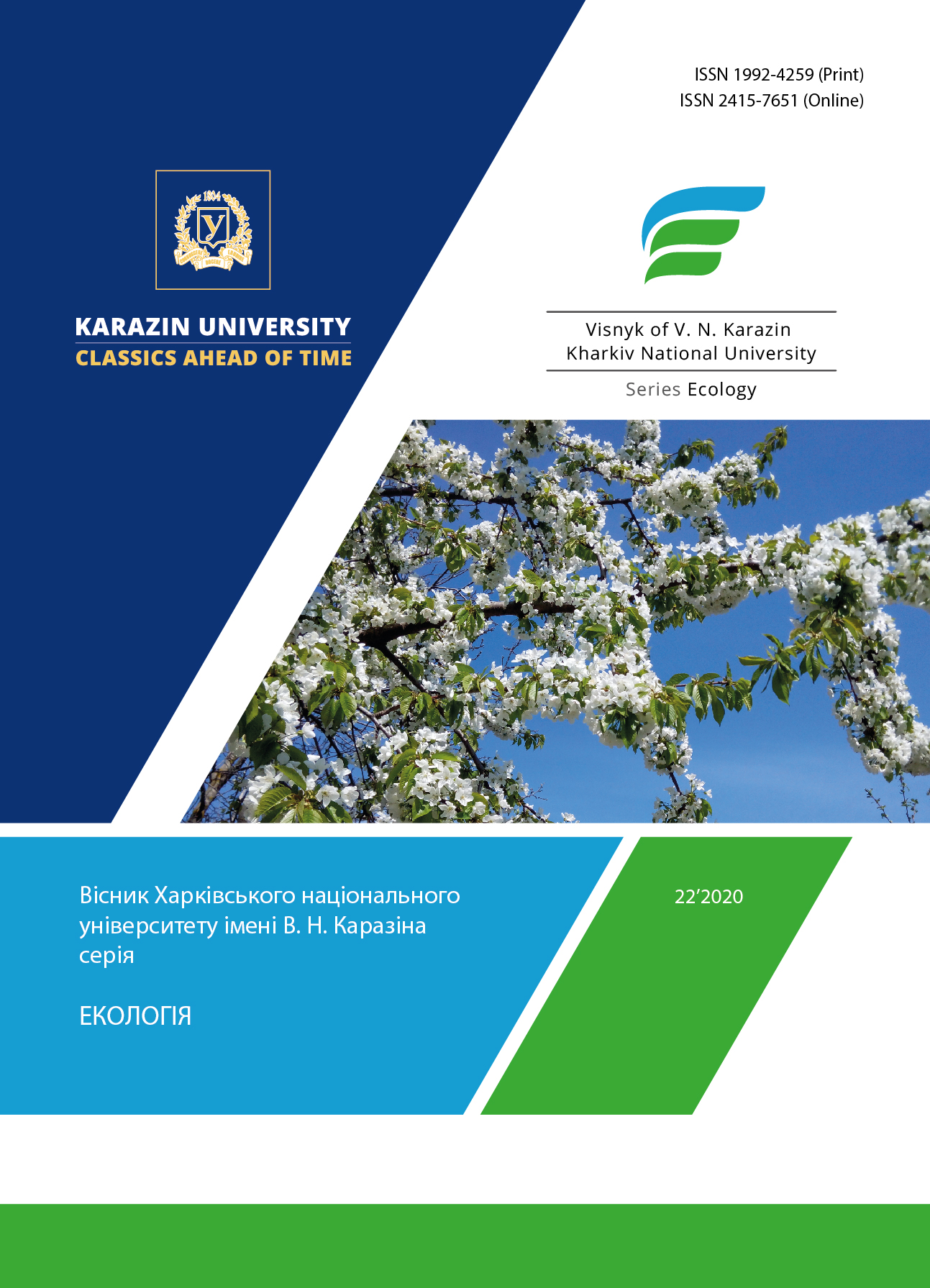The Use of Algae’s Photosynthetic Activity in Toxicity Assessment with the Purpose of Creating Portable Devices
Abstract
The choice of test organisms and test reactions to be used in biotesting devices for wastewater toxicity, including portable ones, is caused by such factors as ease of cultivation and keeping test organisms in the laboratory, relatively high sensitivity to toxic substances, possibility of instrumental recording of physiological indicators used as test reactions on toxicity, a short time from the beginning of the toxicant action to the appearance of changes in the test reaction. Based on these criteria, we can assume that algae are a fairly convenient test organism for instrumental methods of biotesting since they have the a great deal advantages.
Purpose. To find the best options for assessing the photosynthetic activity of algae.
Methods. The polarography method.
Results. The authors have analyzed dependence of the main characteristics of the sensor on the structure of the diffusion layer and temperature and have found out that the optimal choice of the structure can be made depending on the biological object and experimental conditions. The research has shown that test reactions characterizing physiological state of algae are very diverse. This facilitates their choice for the purposes of instrumental toxicity biotesting, including biotesting toxicity of wastewater with portable instruments. Analysis of the experimental data has shown that it is possible to achieve the difference between concentrations of dissolved oxygen in a liquid culture before and after the exposure of the algae of 1-8 mg / l in a sufficiently short period of time by adjusting the density of algal cultures and light intensity. This indicates the fact that in principle it is possible to quantify photosynthetic activity of algae at short time intervals when exposed to light.
Conclusions. The most promising method for assessing the photosynthetic activity of algae is the polarography method, which makes it possible to develop a portable instrument for wastewater toxicity biotesting.
Downloads
References
Krainiukov, O. M. & Yakusheva, A. V. (2020). Research of the possibility of using Ceriodaphnia affinis Lilljeborg (Crustacea) in a short-term test while setting eological quality standards in Ukraine. Visnyk of V. N. Karazin Kharkiv National University, Series "Geology. Geography. Ecology”, (51), 199-206. https://doi.org/10.26565/2410-7360-2019-51-14 (in Ukrainian).
Kostyaev, V., Yagodka, S. & Sokolov, V. (1980). Anabaena spiroides sensitivity to zinc and cobalt. Gidrobiol. magazine, 16(2), 89-92 (in Russian).
Raso, J. & Rachlin, I. (1977). The effect of cadmium, copper, mercuru, zincum and lead on cell division growth and chlorophyll a content a content of the chlorophyte. Chl. vulgaris. Bull. Torreu. Bot. Club., (3), 226-233.
Kravchenko, N. & Gapochka, L. (1977). Effect of petrochemical products on some blue-green algae. Ed. AN Tur. SSR. Ser. “Biol. science", (2), 52-56 (in Russian).
Matorin, D., Venediktov, P. & Makevnina, M. (1977). Application of the method of registration of the afterglow of green algae to determine the contamination of soil and water with phytotoxic substances. Scientific reports High School "Biol. science", (12), 122-125 (in Russian).
Pokrovskaya, N. (1977). The action of propanide and Yalan on the photosynthetic process of the Alaba Anabaena spiroides. Prince Cultivir and approx. microalgae. Tashkent, 22-23 (in Russian).
Shokodko, T. & Merezhko, A. (1978). Changes in the activity of the photosynthetic apparatus of aquatic plants under the action of DDT. Gidrobiol. Magazine, (5), 86-89 (in Russian).
Belghith, T., Athmouni, K., Bellassoued, K., El Feki, A. & Ayadi, H. (2015). Physiological and biochemical response of Dunaliella salina to cadmium pollution. Journal of Applied Phycology, 28(2), 991-999. https://doi.org/10.1007/s10811-015-0630-5
Folgar, S., Torres, E., Pérez-Rama, M., Cid, A., Herrero, C. & Abalde, J. (2009). Dunaliella salina as marine microalga highly tolerant to but a poor remover of cadmium. Journal of Hazardous Materials, 165(1-3), 486–493. https://doi.org/10.1016/j.jhazmat.2008.10.010
García-ríos, V., Freile-pelegrín, Y., Robledo, D., Mendoza-cózatl, D., Moreno-sánchez, R. & Gold-bouchot, G. (2007). Cell wall composition affects Cd2+ accumulation and intracellular thiol peptides in marine red algae. Aquatic Toxicology, 81(1), 65–72. https://doi.org/10.1016/j.aquatox.2006.11.001
Nikookar, K., Moradshahi, A. & Hosseini, L (2005). Physiological responses of Dunaliella salina and Dunaliella tertiolecta to copper toxicity. Biomolecular Engineering, 22(4), 141-146. https://doi.org/10.1016/j.bioeng.2005.07.001
Goryunova, S. (2002). Photo-induced pH change as an integral method for controlling natural and waste waters. Proceedings of the International Conference: New technologies in the protection of biodiversity in aquatic ecosystems, Moscow, 2002, May 27-29 (p. 97). Moscow: Moscow State University (in Russian).
Plekhanov, S., Pimentel, F., Goryunova, S. & Chemeris, Yu. (2004). Early diagnosis of the toxic effect of heavy metals on green microalgae according to their photosynthetic characteristics. Proceedings of the International Conference: Aquatic Ecosystems and Organisms-6, Moscow, 2004, May 18-19 (pp. 87-88). Moscow, MAX Press (in Russian).
Beneche, G. (1977). Automatisierung der auswertur einer algenheteste hemmung der kreichenbewegung einer blaualge (Phornidium sp.) durch deigat. Z. Waasser und Abwasser-Forsch., (6), 195-197.
Einsele, A., Riatroph, D. & Humphereu, A. (1979). Substrate uptacemechanisms for yeast cells. A new approarch utilizing a fluorometer. Eur. J. Appl. Microbiol. and Biotechnol., (4), 335-339.
Healeu, F. & Headzel, L. (1979). Fluorometric measurement of alkaline phosphatase activity in algae. Freshwater Biol., (5), 429-439.
Authors who publish with this journal agree to the following terms:
- Authors retain copyright and grant the journal right of first publication of this work under the terms of a license Creative Commons Attribution License 4.0 International (CC BY 4.0).
- Authors are able to enter into separate, additional contractual arrangements for the non-exclusive distribution of the journal's published version of the work (e.g., post it to an institutional repository or publish it in a book), with an acknowledgement of its initial publication in this journal.
- Authors are permitted and encouraged to post their work online (e.g., in institutional repositories or on their website) prior to and during the submission process, as it can lead to productive exchanges, as well as earlier and greater citation of published work.





